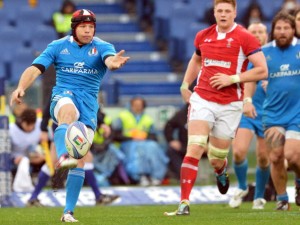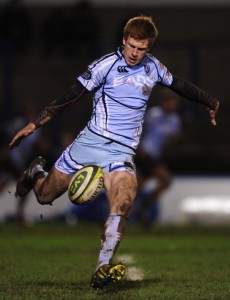
The man everyone’s talking about: Young full-back Jordan Williams will see plenty of action for the Scarlets
By Paul Williams
A promising new crop
There is a farming process known as ‘slash and burn’. It involves setting fire to your land at the end of the season with the aim of nurturing the soil and future crops. Regional rugby in Wales is currently going through this process. Although admittedly Welsh rugby didn’t set its own crop of talent ablaze – it was sparked and fuelled by the gallons of liquid cash that is pouring into the Top 14 and the Aviva Premiership. And whilst supporters, and the media, are justifiably pessimistic about some of Wales’ Grand Slam generation leaving, some of the gaps are already ready to be filled. Jordan Williams, Cory Allen, Ieuan Jones, Dafydd Howells, Owen Williams, Sam Davies, Ellis Jenkins, Jack Dixon, Rhodri Williams, Hallam Amos and Dan Baker are all set to receive meaningful game time this season – not merely sporadic appearances in the LV Cup. The major issue is whether Welsh rugby can create a financial plan that prevents this next generation of players seeking the ‘going rate’ in France and England. If they don’t, regional rugby will have to ‘slash and burn’ every two or three seasons.
Firebreathing Dragons?
Despite valiant efforts from the Newport Gwent Dragons’ players and the coaching staff in recent years, the Dragons have become Wales’ ‘fourth’ region. However, optimism abounds at Rodney Parade. Gareth Davies has been brought into the boardroom and Lyn Jones and Kingsley Jones have been introduced into the changing room. Davies’ appointment as the new CEO is a masterstroke and brings the perfect fusion of rugby and business experience – too often rugby CEO’s lack one or the other. However, it is Lyn Jones’ arrival that has forced a reappraisal of the Dragons. Despite having worked at the Ospreys, with a velvety squad of players, Jones showed at London Welsh that he can also work near miracles on a pittance. Jones has a Second-World-War mentality which thrives on making do and his ability to work with a lean budget is evident at the Dragons. He has a central axis of players around which he can build. Internationals such as Toby Faletau and Andrew Coombs have been reinforced by Richie Rees, Rhys Thomas and Kristopher Burton. The result is a ‘two,four,eight,nine,ten’ spine on which results can be built – and young, gifted players such as Hallam Amos and Jack Dixon can be introduced. The Dragons may not be the ‘fourth’ region for long.
Fatal European ‘Groups of death’
Such is the claustrophobically competitive nature of the Heineken Cup that the Welsh regions are no strangers to a ‘group of death’. However this season the difference between the region’s budgets and their flush counterparts have turned ‘groups of death’ into pools of bubonic plague – the regions’ hopes of making the knockout stages are bleaker than a Siberian midwinter. This isn’t to say that the regions can’t beat the giants of European rugby in one-off fixtures, they can, however the Heineken Cup isn’t about one-off victories. Progressing in the Heineken Cup requires a team to win all of its home games, pick up an elusive away win and a generous helping of bonus points. All of which requires deep squads, purchased with deeper pockets. Sadly, the regions currently have neither.
4G-enius
The decision by Cardiff Blues to install a ‘4G’ surface at Cardiff Arms Park was shrewd. It reduces the negative impact of severe weather and minimises the risk of games being cancelled and the associated loss of revenue. However, by far the most important factor for supporters of the club and the game of rugby, is the quality of rugby that can now be played at the Cardiff Arms Park – which will, in turn, fuel revenue streams. The Cardiff Blues now have year around access to ‘Southern Hemisphere’ rugby conditions. Whilst there are many reasons why Southern Hemisphere rugby teams lead the rugby world in terms of performance, playing conditions are certainly one of them. The impact of the 4G surface can already been seen at Cardiff Arms Park. The Blues recently beat Sale Sharks, admittedly in a pre-season friendly, by 45-24. The Blues haven’t scored 45 points in a single game since they beat Harlequins, in an LV Cup fixture, during the 2011/12 season. But of course the ‘4G’ surface isn’t all good news for the ‘home’ team. Some of the finest ‘away’ teams in Europe will also get to play on this fast, dry surface. I’m sure that Bryan Habana and his Toulon chums will be licking their lips at stretching their legs on the 4G in October. A scary thought.
Rhys Patchell is the answer
Many a question is prefaced with the words “here’s a starter for ten”. In Wales we prefer “‘who’s your starter at 10?”. Welsh supporters are obsessed with the question of who plays at ten for Wales – yet it remains unanswered. James Hook often secures the romantics vote. Hook has always had tremendous lateral movement, a line-splitting dummy and a spiky step and fend. Although Hook’s recent appearances at 15 for Perpignan suggest that he may not feature much at ten this season – even in the Top 14. Rhys Priestland has the desirable ‘flat’ alignment at first receiver and the sympathetic pass that outside backs thrive on. Dan Biggar has a yard-perfect kicking game, great ball skills and a solid defensive skillset. Yet none of the three contenders have consistently quelled their critics. If only it was possible to combine all three players’ skillsets into one? It is. His name is Rhys Patchell and with him Welsh rugby’s perennial question may finally be answered. Expect to see him figuring the end of the season, at the latest.







